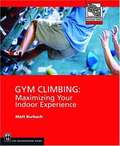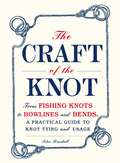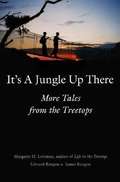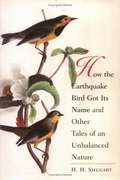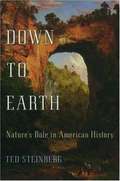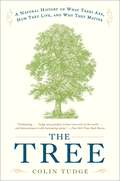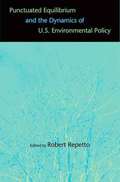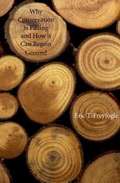- Table View
- List View
Whitetails: Behavior, Ecology, and Conservation
by Erwin A. BauerRevered by hunters and nonhunters alike, the whitetailed deer is the most abundant and best known deer in the world. Unlike most wildlife that roamed the Americas before European colonization, the whitetail now thrives in greater numbers and over a much wider range than it inhabited when the Pilgrims landed at Plymouth Rock. Like no other book before, "Whitetails" features extensive coverage of the species' extraordinary range in maps and outstanding photographs capturing deer in diverse habitats. Reflecting the Bauers' twenty-five years of intensive study and interest, the text presents the full scope of current information on whitetailed deer in seven parts including evolution, behavior, ecosystem, and related species. One section closely follows a year in the animal's life cycle. Another focuses on perhaps the most fascinating aspect of the whitetail-their antlers. In addition to the Bauers' intensive research, their anecdotes and personal observations are included.
Gym Climbing: Maximizing Your Indoor Experience
by Matt BurbachGym climbing has evolved into a sport in its own right and Matt Burbach has been there to spur it on. Burbach covers all aspects of indoor rock climbing in detail, including what to look for in a gym, analysis of equipment and how it works, proper top-rope systems management, and movement technique. More advanced indoor climbers will appreciate chapters on topics such as indoor leading, performance, competition climbing, and bouldering. For outdoor rock climbers now training in gyms, this guide aids the "reverse" transition from climbing on real rock to pulling on plastic. Throughout, Burbach not only demonstrates the proper techniques and skills, but goes one step further to explain why those practices are better.
The Craft of the Knot
by Peter RandallA treasure trove of knot instruction and lore! The Craft of the Knot introduces you to the skill and beauty of knot tying. Filled with detailed instructions, history, and lore, you'll discover a wide range of uses for ordinary rope. From camping and climbing to crafts and sailing, this charming guide also includes knot illustrations for every occasion to show you how to master any tie. Whether you want to brush up on the basics of hitches and bends, or create complex and beguiling decorative knots, The Craft of the Knot provides you with the information you need to fasten the perfect knot every time.
It's a Jungle Up There: More Tales from the Treetops
by Margaret D. Lowman Edward Burgess James Burgess Ghillean T. PranceDrawn to the mysteries of tropical rain forests and fascinated by life in the treetops, Meg Lowman has pursued a life of scientific exploration while raising her two sons, Edward and James Burgess. This book recounts their family adventures in remote parts of the world (Samoa, West Africa, Peru, Panama, India, Biosphere 2, and others), from the perspectives of both kids and parent. Together they explore tropical rain forests, encounter anacondas and piranhas, eat crickets as hors d'oeuvres, discover new species, and nurture a family ethic for conservation. The chapters of the book focus on field biology questions, the canopy access methods developed to answer the questions, and conservation or education components of each expedition. Lowman enumerates the challenges and joys of juggling parenthood and career, and the children reflect on how their mom's work has affected their lives. A rollicking, inspiring book,It's a Jungle Up There is an upbeat portrayal of how a parent's career can imprint children, and how children in turn can influence the success and trajectory of their parent's career.
How the Earthquake Bird Got Its Name: And Other Tales of an Unbalanced Nature
by H. H. ShugartAlthough people have been altering earth's landscapes to some extent for tens of thousands of years, humankind today is causing massive changes to the planet. Such widespread environmental change is accompanied by accelerating rates of species extinction. In this book, noted ecologist H. H. Shugart presents important ecological concepts through entertaining animal parables. He tells the stories of particular birds and mammals--the packrat, ivory-billed woodpecker, penguin, dingo, European rabbit, and others--and what their fates reveal about the interactions between environmental change and the extinctions or explosions of species populations. Change is the root of many planetary problems, but it is also an intrinsic feature of our living planet. Shugart explores past environmental change, discusses the non-existence of a "balance of Nature," and documents how human alterations have affected plants, soils, and animals. He looks with hope toward a future in which thoughtful people learn-and use-ecological science to protect the landscapes upon which terrestrial creatures depend.
The World of the Otter (Living World Book)
by Ed ParkEver wondered how those otters on the river bank are so playful, what do they eat, where do they live, how do they survive the winter? In this book by naturalist Ed Park, who has studied otters for years, you will find the answers to these questions and get to know the clowns of the river bank more closely.
Down to Earth: Nature's Role in American History
by Ted SteinbergDown to Earth offers a sweeping history of our nation, one that for the first time places the environment at the very center of our story. Writing with marvelous clarity, historian Ted Steinberg sweeps across the centuries, re-envisioning the story of America as he recounts how the environment has played a key role in virtually every social, economic, and political development.
The Tree: A Natural History of What Trees Are, How They Live, and Why They Matter
by Colin TudgeFrom tiny saplings to centuries-old redwoods and desert palms, from the backyards of the American heartland to the rain forests of the Amazon and the bamboo forests, Colin Tudge takes the reader on a journey through history and illuminates our ever-present but often ignored companions. A blend of history, science, philosophy, and environmentalism, The Tree is an engaging and elegant look at the life of the tree and what modern research tells us about their future.
Punctuated Equlibrium and the Dynamics of U. S. Environmental Policy
by Robert Repetto James Gustave SpethAlthough many environmental policy issues remain deadlocked for decades with little movement, sometimes breakthroughs occur abruptly. Why do deadlocks persist? Why do major policy shifts occur infrequently? Is it possible to judge when policies are ripe for change? This book presents new empirical evidence that the punctuated equilibrium theory of policy dynamics fits the facts of environmental policy change and can explain how stable policies can suddenly unravel in discontinuous change. The distinguished contributors to the volume apply the theory to a wide range of important environmental and resource issues and assess case histories in water, forestry, fisheries, public lands, energy and climate some of which resulted in breakthroughs, others in stalemate. They offer insights into the political conditions and tactics that are likely to produce these disparate outcomes. Every professional, activist, and student concerned with promoting (or resisting) change in environmental and natural resources policies will find this up-to-date book an invaluable guide.
Why Conservation Is Failing and How It Can Regain Ground
by Eric T. FreyfogleCritics of environmental laws complain that such rules often burden people unequally, restrict individual liberty, and undercut private property rights. In formulating responses to these criticisms, the conservation effort has stumbled badly, says Eric T. Freyfogle in this thought-provoking book. Conservationists and environmentalists haven't done their intellectual homework, he contends, and they have failed to offer an understandable, compelling vision of healthy lands and healthy human communities. Freyfogle explores why the conservation movement has responded ineffectually to the many cultural and economic criticisms leveled against it. He addresses the meaning of good land use, describes the many shortcomings of "sustainability," and outlines six key tasks that the cause must address. Among these is the crafting of an overall goal and a vision of responsible private ownership. The book concludes with a stirring message that situates conservation within America's story of itself and with an extensive annotated bibliography of conservation's most valuable voices and texts--important information for readers prepared to take conservation more seriously.
Social Networks and Natural Resource Management: Uncovering the Social Fabric of Environmental Governance
by Örjan Bodin Christina PrellSocial Network Analysis (SNA), a quantitative approach to the study of social relations, has recently emerged as a key tool for understanding the governance of natural resources. Bringing together contributions from a range of researchers in the field, this is the first book to fully explore the potential applications of SNA in the context of natural resource management. Topics covered include the role of SNA in stakeholder selection; improving fisheries management and conservation; the effect of social network ties on public satisfaction and agrarian communication networks. Numerous case studies link SNA concepts to the theories underlying natural resource governance, such as social learning, adaptive co-management and social movements theory. Reflecting on the challenges and opportunities associated with this evolving field, this is an ideal resource for students and researchers involved in many areas of natural resource management, environmental biology, sustainability science and sociology.
Zoo Conservation Biology
by Donnamarie O'Connell Stephan M. Funk John E. FaIn the face of ever-declining biodiversity, zoos have a major role to play in species conservation. Written by professionals involved in in-situ conservation and restoration projects internationally, this is a critical assessment of the contribution of zoos to species conservation through evidence amassed from a wide range of sources. The first part outlines the biodiversity context within which zoos should operate, introducing the origins and global spread of zoos and exploring animal collection composition. The second part focuses on the basic elements of keeping viable captive animal populations. It considers the consequences of captivity on animals, the genetics of captive populations and the performance of zoos in captive breeding. The final part examines ways in which zoos can make a significant difference to conservation now and in the future. Bridging the gap between pure science and applied conservation, this is an ideal resource for both conservation biologists and zoo professionals.
Environmental Literacy in Science and Society
by Roland W. ScholzIn an era where humans affect virtually all of the earth's processes, questions arise about whether we have sufficient knowledge of human-environment interactions. How can we sustain the Earth's ecosystems to prevent collapses and what roles should practitioners and scientists play in this process? These are the issues central to the concept of environmental literacy. This unique book provides a comprehensive review and analysis of environmental literacy within the context of environmental science and sustainable development. Approaching the topic from multiple perspectives, it explores the development of human understanding of the environment and human-environment interactions in the fields of biology, psychology, sociology, economics and industrial ecology. The discussion emphasises the importance of knowledge integration and transdisciplinary processes as key strategies for understanding complex human-environment systems (HES). In addition, the author defines the HES framework as a template for investigating sustainably coupled human-environment systems in the 21st century.
Sources, Sinks and Sustainability
by Jianguo Liu Vanessa Hull Anita T. Morzillo John A. WiensSource-sink theories provide a simple yet powerful framework for understanding how the patterns, processes and dynamics of ecological systems vary and interact over space and time. Integrating multiple research fields, including population biology and landscape ecology, this book presents the latest advances in source-sink theories, methods and applications in the conservation and management of natural resources and biodiversity. The interdisciplinary team of authors uses detailed case studies, innovative field experiments and modeling, and comprehensive syntheses to incorporate source-sink ideas into research and management, and explores how sustainability can be achieved in today's increasingly fragile human-dominated ecosystems. Providing a comprehensive picture of source-sink research as well as tangible applications to real world conservation issues, this book is ideal for graduate students, researchers, natural-resource managers and policy makers.
Climate Change in the Polar Regions
by John Turner Gareth J. MarshallThe polar regions have experienced some remarkable environmental changes in recent decades, such as the Antarctic ozone hole, the loss of large amounts of sea ice from the Arctic Ocean and major warming on the Antarctic Peninsula. The polar regions are also predicted to warm more than any other region on Earth over the next century if greenhouse gas concentrations continue to rise. Yet trying to separate natural climate variability from anthropogenic factors still presents many problems. This book presents a thorough review of how the polar climates have changed over the last million years and sets recent changes within a long term perspective. The approach taken is highly cross-disciplinary and the close links between the atmosphere, ocean and ice at high latitudes are stressed. The volume will be invaluable for researchers and advanced students in polar science, climatology, global change, meteorology, oceanography and glaciology.
Restoration and Reclamation of Boreal Ecosystems
by Dale H. Vitt Jagtar S. BhattiBoreal ecosystems contain one-third of the world's forests and stored carbon, but these regions are under increasing threat from both natural and anthropogenic disturbances. Written by leaders from the forefront of private, public and academic sectors, Restoration and Reclamation of Boreal Ecosystems emphasises a broad, conceptual approach to the specific application of empirical research into development planning, restoration and modelling of these ecosystems. The importance of this is highlighted at a time of global climate change, as these ecosystems act as carbon sinks. There is a focus on the reclamation of exploited ecosystems from a holistic standpoint, ranging from environmental and edaphic variables to the restoration of keystone flora. Recent advances in quantification of ecosystem services, such as habitat suitability and carbon storage modelling, are also detailed. The book contains case-studies which address how both historical and novel assemblages can provide ecosystem stability under projected climatic and land-use scenarios.
Economics and the Challenge of Global Warming
by Charles S. PearsonEconomics and the Challenge of Global Warming is a balanced and comprehensive analysis of the role of economics in confronting global warming, the central environmental issue of the twenty-first century. It avoids a technical exposition in order to reach a wide audience and is up to date in its theoretical and empirical underpinnings. It is addressed to all who have some knowledge of economic concepts and a serious interest in how economics can (and cannot) help in crafting climate policy. The book is organized around three central questions. First, can benefit-cost analysis guide us in setting warming targets? Second, what strategies and policies are cost-effective? Third, and most difficult, can a global agreement be forged between rich and poor, North and South? While economic concepts are foremost in the analysis, they are placed within an accessible ethical and political matrix. The book serves as a primer for the post-Kyoto era.
Flowers on the Tree of Life
by Livia Wanntorp Louis P. Ronse De CraeneGenetic and molecular studies have recently come to dominate botanical research at the expense of more traditional morphological approaches. This broad introduction to modern flower systematics demonstrates the great potential that floral morphology has to complement molecular data in phylogenetic and evolutionary investigations. Contributions from experts in floral morphology and evolution take the reader through examples of how flowers have diversified in a large variety of lineages of extant and fossil flowering plants. They explore angiosperm origins and the early evolution of flowers and analyse the significance of morphological characters for phylogenetic reconstructions on the tree of life. The importance of integrating morphology into modern botanical research is highlighted through case studies exploring specific plant groups where morphological investigations are having a major impact. Examples include the clarification of phylogenetic relationships and understanding the significance and evolution of specific floral characters, such as pollination mechanisms and stamen and carpel numbers.
Marine Protected Areas
by Joachim ClaudetHuman-induced environmental disturbance - through fishery activities, coastal development, tourism and pollution - is a major challenge to the restoration and conservation of marine biodiversity. Synthesizing the latest research into marine biodiversity conservation and fisheries management, this book provides regional and global perspectives on the role of Marine Protected Areas (MPAs) in confronting this challenge. The approach is multidisciplinary, covering all the fields involved in designating and assessing MPAs: ecology, fisheries science, statistics, economics, sociology and genetics. The book is structured around key topics, including threats to marine ecosystems and resources, the effects and effectiveness of MPAs and the scaling-up of MPA systems. Both theoretical and empirical approaches are considered. Recognizing the diversity of MPA sciences, the book also includes one part designed specifically as a practical guide to implementing scientific assessment studies of MPAs and monitoring programs.
Introduction to Modern Climate Change
by Andrew E. DesslerThis textbook is tightly focused on the problem of anthropogenic climate change. It is unique among textbooks on climate change in that it combines an introduction of the science with an introduction to the non-science issues such as the economic and policy options. Unlike more purely descriptive textbooks, it contains the quantitative depth that is necessary for an adequate understanding of the science of climate change. The goal of the book is for a student to leave the class ready to engage in the public policy debate on this issue. This is an invaluable textbook for any introductory survey course on the science and policy of climate change, for both non-science majors and introductory science students.
Terrestrial Ecosystem Ecology
by Göran I. Ågren Folke O. AnderssonHuman activities impact the environment and modify the cycles of important elements such as carbon and nitrogen from local to global scales. In order to maintain long-term and sustainable use of the world's natural resources it is important that we understand how and why ecosystems respond to such changes. This book explains the structure and functioning of terrestrial ecosystems, using examples ranging from the Arctic to the tropics to demonstrate how they react under differing conditions. This knowledge is developed into a set of principles that can be used as starting points for analysing questions about ecosystem behaviour. Ecosystem dynamics are also considered, illustrating how ecosystems develop and change over a range of temporal and spatial scales and how they react to perturbations, whether natural or man-made. Throughout the book, descriptive studies are merged with simple mathematical models to reinforce the concepts discussed and aid the development of predictive tools.
Forest Health: An Integrated Perspective
by John D. Castello Stephen A. TealeForest Health: An Integrated Perspective is the first book to define an ecologically rational, conceptual framework that unifies and integrates the many sub-disciplines that comprise the science of forest health and protection. This new global approach applies to boreal, temperate, tropical, natural, managed, even-aged, uneven-aged and urban forests, as well as plantations. Readers of the text can use real datasets to assess the sustainability of four forests around the world. Datasets for the case studies are at www.cambridge.org/9780521766692, and the text provides stepwise instructions for performing the calculations in Microsoft Excel. Readers can follow along as the editors perform the same calculations and interpret the results. Elevating forest health from a fuzzy concept to an ecologically sound paradigm, this is essential reading for undergraduate and graduate students and professionals interested in forest health, protection, entomology, pathology and ecology.
Management of Freshwater Biodiversity
by Julian Reynolds Catherine Souty-Grosset Keith CrandallIntegrating research into freshwater biodiversity and the role of keystone species, this fascinating book presents freshwater crayfish as representatives of human-exacerbated threats to biodiversity and conservation. It uses examples from these and other large decapod invertebrates to explore how communities function and are controlled, alongside the implications of human demands and conflicts over limited resources, notably the severe impacts on biodiversity. The discussion is structured around three key topics - the present situation of crayfish in world freshwater ecosystems, the applications of science to conservation management and knowledge transfer for successful crayfish management. It outlines the historic exploitation of crayfish, addressing the problems caused by invasive alien forms and explaining the importance of correct identification when dealing with conservation issues. Offering a global perspective on freshwater systems, the book ultimately highlights how the conservation of such large and long-lived species will help protect ecosystem quality in the future.
Global Climate Governance Beyond 2012
by Frank Biermann Fariborz Zelli Philipp PattbergAn assessment of policy options for future global climate governance, written by a team of leading experts from the European Union and developing countries. Global climate governance is at a crossroads. The 1997 Kyoto Protocol was merely a first step, and its core commitments expire in 2012. This book addresses three questions which will be central to any new climate agreement. What is the most effective overall legal and institutional architecture for successful and equitable climate politics? What role should non-state actors play, including multinational corporations, non-governmental organizations, public-private partnerships and market mechanisms in general? How can we deal with the growing challenge of adapting our existing institutions to a substantially warmer world? This important resource offers policy practitioners in-depth qualitative and quantitative assessments of the costs and benefits of various policy options, and also offers academics from wide-ranging disciplines insight into innovative interdisciplinary approaches towards international climate negotiations.
Introduction to the Physical and Biological Oceanography of Shelf Seas
by John H. Simpson Jonathan SharplesIn this exciting and innovative textbook, two leading oceanographers bring together the fundamental physics and biology of the coastal ocean in a quantitative but accessible way for undergraduate and graduate students. Shelf sea processes are comprehensively explained from first principles using an integrated approach to oceanography that helps build a clear understanding of how shelf sea physics underpins key biological processes in these environmentally sensitive regions. Using many observational and model examples, worked problems and software tools, the authors explain the range of physical controls on primary biological production and shelf sea ecosystems. Boxes throughout the book present extra detail for each topic and non-mathematical summary points are provided for physics sections, allowing students to develop an intuitive understanding. The book is fully supported by extensive online materials, including worked solutions to end-of-chapter exercises, additional homework/exam problems with solutions and simple MATLAB and FORTRAN models for running simulations.

